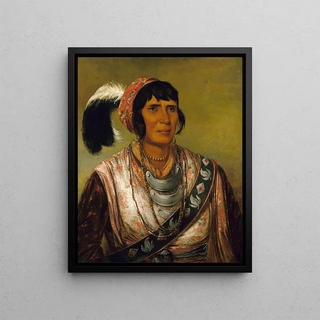Art print | Osceol The Black Drink, a highly distinguished warrior - George Catlin Source: Reproduction | Osceol The Black Drink, un guerrier de grande distinction - George Catlin


View from behind

Frame (optional)
In the fascinating world of 19th-century American art, the artwork "Osceol The Black Drink, a distinguished warrior" by George Catlin stands out for its narrative depth and commitment to representing Native American cultures. This painting, which captures the strength and dignity of a Seminole chief, invites us to delve into a world where identity and heritage intertwine with aesthetic beauty. Catlin, as an ethnographer and artist, masterfully immortalized key moments in the lives of indigenous peoples, and this art print is a poignant testament to that. The art print Osceol The Black Drink, a distinguished warrior - George Catlin, offers an entry point into this bygone era, while prompting reflection on the cultural and historical issues that still persist.
Style and uniqueness of the work
Catlin's work is characterized by a distinctive style that combines realism and romanticism. In "Osceol The Black Drink," vibrant colors and meticulous details come together to create a striking image. Osceol's proud and determined gaze, along with his traditional ornaments, testify to a culture rich in symbolism and history. Catlin does not merely depict his subject; he seeks to capture the very essence of the individual, paying homage to his bravery and resilience. The composition, well-balanced, highlights the warrior in an environment that evokes both the wild nature and the weight of traditions. This artwork is not limited to a simple visual representation; it tells a story, that of a man and a people fighting for their survival and identity.
The artist and his influence
George Catlin, often considered the first artist to document Native American cultures, had a lasting influence on the perception of these peoples in Western art and culture. Traveling across the United States, he met many tribes and established an authentic connection with his subjects. His work goes beyond mere aesthetics; it is part of a cultural preservation effort, providing a visual testimony at a time when indigenous peoples were

Matte finish

View from behind

Frame (optional)
In the fascinating world of 19th-century American art, the artwork "Osceol The Black Drink, a distinguished warrior" by George Catlin stands out for its narrative depth and commitment to representing Native American cultures. This painting, which captures the strength and dignity of a Seminole chief, invites us to delve into a world where identity and heritage intertwine with aesthetic beauty. Catlin, as an ethnographer and artist, masterfully immortalized key moments in the lives of indigenous peoples, and this art print is a poignant testament to that. The art print Osceol The Black Drink, a distinguished warrior - George Catlin, offers an entry point into this bygone era, while prompting reflection on the cultural and historical issues that still persist.
Style and uniqueness of the work
Catlin's work is characterized by a distinctive style that combines realism and romanticism. In "Osceol The Black Drink," vibrant colors and meticulous details come together to create a striking image. Osceol's proud and determined gaze, along with his traditional ornaments, testify to a culture rich in symbolism and history. Catlin does not merely depict his subject; he seeks to capture the very essence of the individual, paying homage to his bravery and resilience. The composition, well-balanced, highlights the warrior in an environment that evokes both the wild nature and the weight of traditions. This artwork is not limited to a simple visual representation; it tells a story, that of a man and a people fighting for their survival and identity.
The artist and his influence
George Catlin, often considered the first artist to document Native American cultures, had a lasting influence on the perception of these peoples in Western art and culture. Traveling across the United States, he met many tribes and established an authentic connection with his subjects. His work goes beyond mere aesthetics; it is part of a cultural preservation effort, providing a visual testimony at a time when indigenous peoples were






